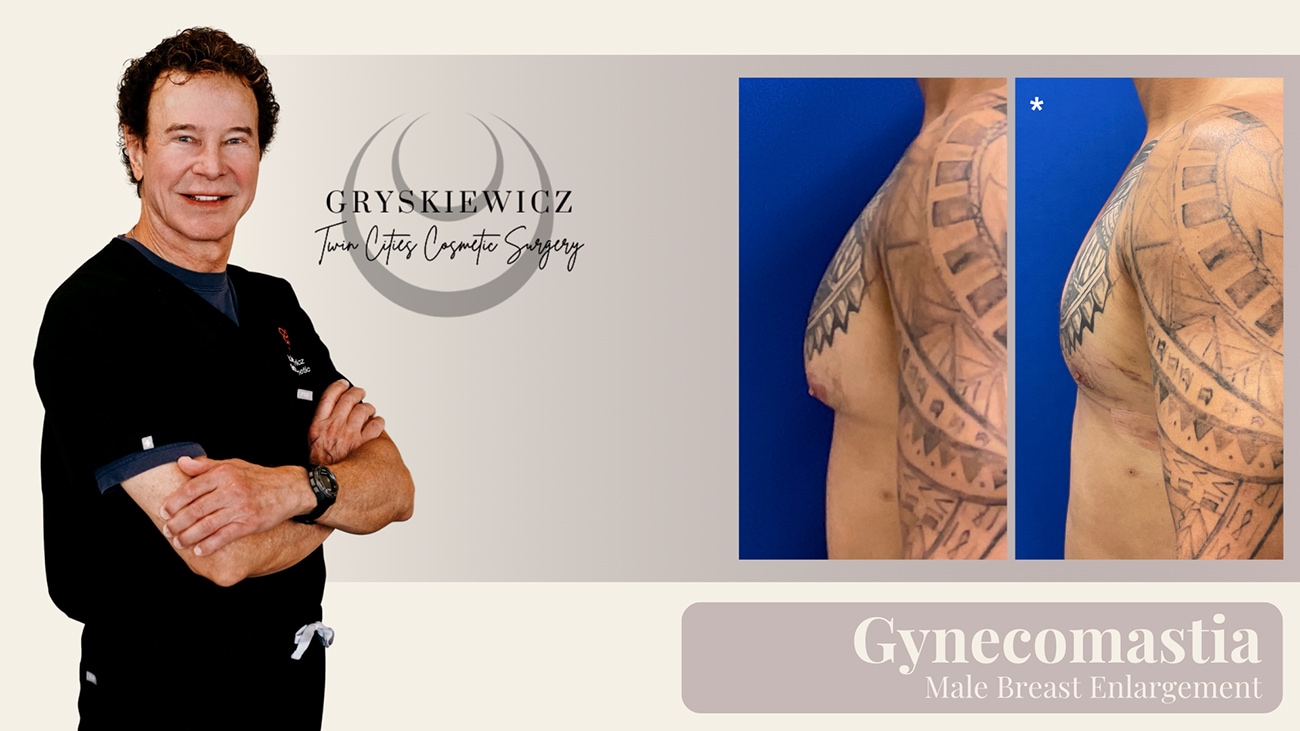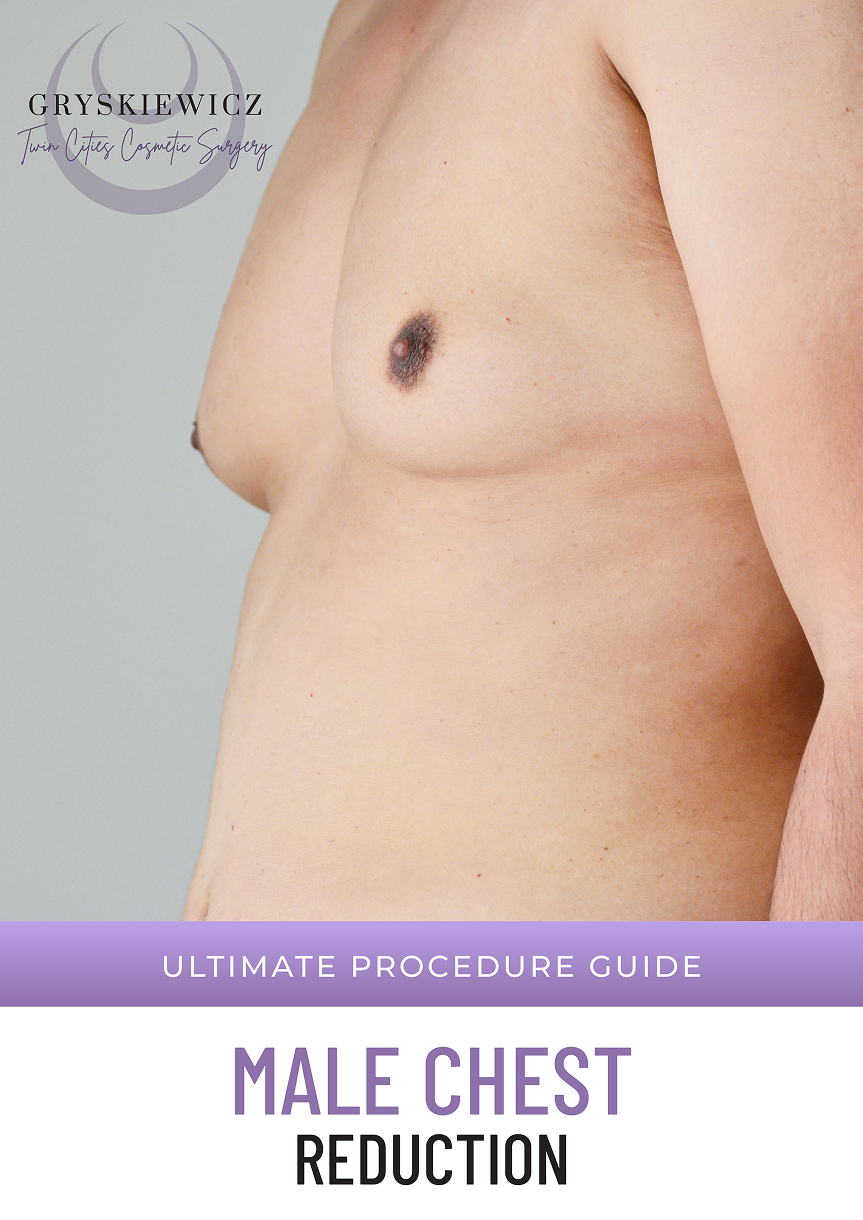Gynecomastia: Can Exercise Alone Treat Enlarged Male Breasts?
Gynecomastia, a condition characterized by enlarged male breasts, affects a significant portion of the male population. While the development of excess glandular breast tissue can be distressing, it is essential to understand that gynecomastia is a common condition that can also be associated with breast pain.
In fact, studies suggest that up to 65% of men experience some degree of gynecomastia during their lifetime. In this article, Minneapolis Plastic Surgeon Dr. Joe Gryskiewicaims to discuss the causes of gynecomastia, its psychological impact, and the effectiveness of exercise in treating the condition.
What Causes Gynecomastia?
Gynecomastia often stems from hormonal imbalances, particularly an elevated ratio of estrogen to androgens like testosterone. This imbalance in testosterone levels can occur during various stages of life, such as puberty (pubertal gynecomastia), middle age, and older adulthood. However, hormonal fluctuations and androgens or testosterone are not the only culprits behind gynecomastia.
Certain medications, including anabolic steroids, antidepressants, and some heart medications, can also contribute to an increased risk of gynecomastia. Additionally, health conditions like liver disease, kidney failure, and thyroid disorders have been linked to this condition.
Gynecomastia can also occur when a tumor is present in the testicles or the adrenal glands, which are responsible for the production of testosterone. Tumors may lead to an overproduction of hormones, hormone imbalance or disrupt the normal endocrine functions, resulting in imbalances that cause breast tissue enlargement.
Some lifestyle factors and environmental influences can also play a role in the onset of pubertal gynecomastia for some patients. For instance, the use of substances such as marijuana, alcohol, and certain recreational drugs are associated with changes in hormone levels that may precipitate the condition. Additionally, exposure to endocrine-disrupting chemicals (EDCs) found in various consumer products, such as plastics and personal care items, can interfere with hormonal balance and potentially lead to symptoms of gynecomastia.
Moreover, obesity is a significant factor that can exacerbate the condition. Excess body fat, particularly around the breast area, can lead to increased estrogen production while simultaneously decreasing testosterone levels. This creates a feedback loop that can further worsen the enlarged breast gland tissue. As men accumulate weight, many find that fat cells convert testosterone into estrogen, inevitably contributing to the hormonal imbalance associated with this condition.
Lastly, genetics may play a role in predisposing certain individuals to gynecomastia. Family histories of the condition might indicate inherited traits that make some patients more susceptible to hormonal fluctuations or the accumulation of breast tissue. Therefore, if you have relatives who have experienced idiopathic gynecomastia, you might be at a higher risk of gynecomastia.
The Psychological Impact of Gynecomastia
Living with a diagnosis of gynecomastia can have a profound impact on a man’s emotional well-being, often leading to a range of psychological challenges. Many men with enlarged breasts experience feelings of low self-esteem, embarrassment, and anxiety, which can permeate various aspects of their lives. The constant self-consciousness about their appearance can cause them to withdraw from social situations, such as going to the beach, participating in sports, or even engaging in intimate relationships.
The emotional toll of pubertal gynecomastia can be particularly severe during adolescence, a time when body image concerns are often at their peak. Adolescent males with pubertal gynecomastia may face teasing and bullying from their peers, which can further exacerbate feelings of shame and inadequacy. These negative experiences can lead to a lack of confidence that extends well into adulthood, affecting their ability to form meaningful connections and pursue their goals.
Moreover, the psychological impact of idiopathic gynecomastia can spill over into professional settings. Men with enlarged breasts may feel uncomfortable in certain clothing or avoid situations that require them to dress in form-fitting attire, such as business meetings or networking events. This self-consciousness can hinder their ability to focus on their work and advance in their careers.
The emotional burden of this condition can also take a toll on mental health, with some patients experiencing symptoms of depression and anxiety. The constant worry and stress associated with the condition can lead to a diminished quality of life, causing men to miss out on valuable experiences and opportunities.
It is important for men with this condition to recognize that they are not alone in their struggles. Millions of men worldwide grapple with this condition, and seeking support from loved ones, mental health professionals, or support groups can be incredibly beneficial. Additionally, it is essential to understand that there are solutions available to help alleviate the physical and emotional burden of gynecomastia, such as male breast reduction surgery.
Can Exercise Reduce Male Breast Size?
Exercise is often suggested as a treatment of gynecomastia for men seeking to reduce the appearance of enlarged breasts. While regular physical activity can contribute to overall health and improve chest appearance, it is important to understand the limitations of exercise in treating this condition.
Engaging in a consistent exercise routine, particularly one that includes strength training, can help develop and tone the pectoral muscles. By building muscle mass in the chest area, men can create a more masculine and defined chest contour. Exercises such as push-ups, bench presses, and chest flys target the pectoral muscles, which can lead to a firmer and more sculpted appearance over time.
However, it is important to recognize that exercise primarily targets the muscles beneath the breast tissue, not the glandular tissue itself. Idiopathic gynecomastia is often a combination of both fatty tissue and glandular tissue, and this is where the challenge lies in treating the condition through exercise alone.
Exercise can indeed define the chest muscles, but it is rarely an effective treatment for gynecomastia for two reasons. First, enlarged male breast tissue is typically the result of a hormonal imbalance rather than extra body fat, limiting the extent to which exercises can properly contour the chest. Second, enlarged breasts are often a combination of both fatty tissue and glandular tissue. Since glandular tissue is not affected by exercise, visible male breasts can persist despite the most intensive workouts.
Cardiovascular exercise, such as running, cycling, or swimming, can also have effects on reducing overall body fat, including the fatty tissue in the breasts. By creating a calorie deficit through regular aerobic activity and a balanced diet, men can work towards losing excess fat throughout their bodies. This can lead to a reduction in the size of the breasts, as the fatty tissue diminishes.
However, glandular tissue, which is a key component of idiopathic gynecomastia, is not significantly affected by exercise. Glandular tissue is firm and dense, unlike the softer fatty tissue, and it does not respond to the same weight loss mechanisms as fat does. This means that even with dedicated exercise efforts and successful fat reduction, men with this condition may still have noticeable breast enlargement due to the persistent glandular tissue.
It is also worth noting that spot reduction, or the idea of targeting fat loss in specific areas of the body through exercise, is a myth. While certain exercises can help tone and strengthen particular muscle groups, they cannot selectively burn fat from those areas. Fat loss occurs throughout the body as a whole, rather than in isolated regions.
For patients who have achieved a healthy body weight and have maintained a consistent exercise regimen but still struggle with gynecomastia, alternative medical treatment options may be necessary. Male breast reduction surgery, which involves the removal of excess glandular tissue and fat, can provide a more definitive solution for those seeking to achieve a flatter and more masculine chest contour.
Male Breast Reduction Surgery – Surgical Treatment for Gynecomastia
For men who have tried exercise and other non-surgical methods without success, male breast reduction surgery offers a treatment for gynecomastia. This surgical procedure aims to remove excess fat and glandular tissue while recontouring the chest for a more masculine appearance.
Dr. Joe employs advanced techniques to ensure optimal results with minimal scarring. Liposuction is used to remove excess fatty tissue, while glandular tissue is carefully excised through small incisions. Unlike some surgeons who make incisions on the areola or nipple area, Dr. Joe strategically places incisions on the rib cage to minimize visible scarring.
Who is a Good Candidate for Surgery?
Candidates for male breast reduction surgery are typically men who are in good overall health, nonsmokers, and have realistic expectations about the procedure. During the consultation, Dr. Joe will perform a physical examination and assess your specific needs to develop a personalized treatment plan.
What Happens on the Day of Surgery?
On the day of the surgery, you will be given anesthesia to ensure comfort throughout the procedure. The surgery usually takes about 1-2 hours, depending on the extent of the correction needed. Following the procedure, you can expect some swelling, bruising, and discomfort, which can be managed with prescribed pain medication. Most patients can return to work within a week, although strenuous activities should be avoided for several weeks.
How Dr. Joe Performs Surgery?
When reducing breast tissue, Dr. Joe nevers make an incision on the areola or nipple area, which is a dead giveaway of previous surgery. Instead, he usually makes two inconspicuous and somewhat asymmetrical half-inch long incisions on the rib cage to hide the scars. He then uses tumescent fluid and a power-assisted liposuction machine to suction the more fibrous male fat. If any firm tissue remains, he usesuse custom-designed long narrow instruments to fish out any remnants for a flat chest. Dr Joe can also also perform liposuction around the rib cage and over the upper pectoral area if needed.
How are Surgical Risks managed?
As with any surgical procedure, there are potential risks and complications associated with male breast reduction, including bleeding, infection, and changes in nipple sensation. However, these risks are minimized when the surgery is performed by an experienced, board-certified plastic surgeon like Dr. Joe.
See Before-and-After Photos
To visualize the results of male breast reduction surgery, we invite you to browse our before-and-after photos gallery featuring real patients who have undergone the procedure with Dr. Joe.
FAQs about Gynecomastia Surgery
Are the results of male breast reduction surgery permanent?
Male breast reduction surgery can provide long-lasting results, particularly regarding the removal of excess glandular tissue, which typically does not regrow. However, the permanence of fat removal results may be influenced by lifestyle factors and weight fluctuations after surgery. Significant weight gain or loss can affect the chest contour. To maintain the results, you should adopt a healthy lifestyle with regular exercise and a balanced diet. Certain medications and medical conditions that influence hormone levels may also contribute to gynecomastia recurrence. While natural aging can cause changes in skin elasticity and body composition, these changes are usually gradual and less noticeable compared to the initial improvement achieved through surgery.
Is there an age limit for undergoing male breast reduction surgery?
There is no strict age limit for male breast reduction surgery, but Dr. Joe generally recommends waiting until breast development has stabilized, typically in the late teenage years or early adulthood. In adolescent males, pubertal gynecomastia may resolve on its own as hormone levels balance out. However, in cases of persistent symptoms of gynecomastia causing significant discomfort or distress, earlier surgical intervention may be considered for some patients after careful evaluation. Patients have no upper age limit, provided they are in good health and have realistic expectations. The decision to undergo surgery should be based on individual circumstances and only after a physical examination performed by an experienced plastic surgeon.
How can I maintain the results of my male breast reduction surgery?
To maintain the results of male breast reduction surgery, patients should focus on maintaining a stable, healthy body weight through regular exercise and a balanced diet. Significant weight fluctuations can impact the chest appearance, with weight gain leading to excess fat accumulation and weight loss causing loose skin. Patients should also be aware of medications and medical conditions that may have effects on hormone levels and contribute to gynecomastia recurrence. Adhering to a healthy lifestyle, attending follow-up appointments with Dr. Joe, and addressing any concerns promptly can help ensure long-lasting results. Additionally, protecting the skin from sun damage and avoiding smoking can promote overall skin health and maintain the surgical outcome.
Can Gynecomastia be a sign of testicular tumor?
Gynecomastia can indeed be a symptom of various underlying health conditions, including testicular tumors. While not all cases of gynecomastia are linked to malignancies, it’s crucial to understand the potential associations and the need for thorough physical examination. Testicular tumors can sometimes lead to hormonal imbalances in the body. These tumors may secrete hormones, such as human chorionic gonadotropin (hCG), which can stimulate breast tissue growth and result in gynecomastia. Therefore, while the presence of gynecomastia doesn’t automatically imply the presence of a testicular tumor, it can be a sign that warrants further investigation.
Will I have visible scars after male breast reduction surgery?
One of the common concerns among men considering male breast reduction surgery after a diagnosis of gynecomastia is the potential for visible scars. While any surgical procedure will result in some degree of scarring, the extent and appearance of scars after gynecomastia surgery can vary depending on the specific surgical technique used and individual factors such as skin type and healing response. Dr. Joe uses advanced techniques to minimize the size and visibility of scars. The incision placement is carefully planned to ensure that scars are as inconspicuous as possible, often located along the natural contours of the chest or around the areola.
Final Thoughts From Dr. Joe
Gynecomastia can be a source of significant emotional distress for many men, but it is essential to remember that it is a common condition and that effective treatment options are available. While exercise can improve overall chest appearance, it may not be sufficient to address the underlying glandular tissue that contributes to this issue and can’t be considered an effective treatment of gynecomastia.
For men who have struggled with the condition and have not found success through non-surgical methods, male breast reduction surgery offers a comprehensive solution. By removing excess fat and glandular tissue, this procedure can help restore a more masculine chest contour and boost self-confidence.
If you are struggling with this condition and would like to learn more about your surgical treatment options, we encourage you to schedule a consultation with Dr. Joe. During your consultation, Dr. Joe will listen to your concerns, perform a physical examination, and develop a personalized treatment plan to help you achieve your goals. Take the first step toward reclaiming your confidence and contact our office today.
Further Reading about Plastic Surgery for Men with Dr. Joe
- Read Dr. Joe’s Male Breast Reduction (Gynecomastia Treatment) Page
- Read Dr. Joe’s Blog about How to Exercise after Gynecomastia Surgery
- Read Dr. Joe’s Blog about What Causes Man Boobs
- See Dr. Joe’s Blog Gynecomastia Before and After Photo Gallery
Medical References for Gynecomastia
- Study – Gynecomastia: Etiology, Diagnosis, and Treatment
- Study – The round-the-clock technique for correction of gynecomastia
- Study – Minimal Incision Technique for Gynecomastia
- Study – Gynecomastia: glandular-liposculpture through a single transaxillary one hole incision
- Study – Severe Gynecomastia: New Technique Using Superior Pedicle NAC Flap Through a Circumareolar Approach




